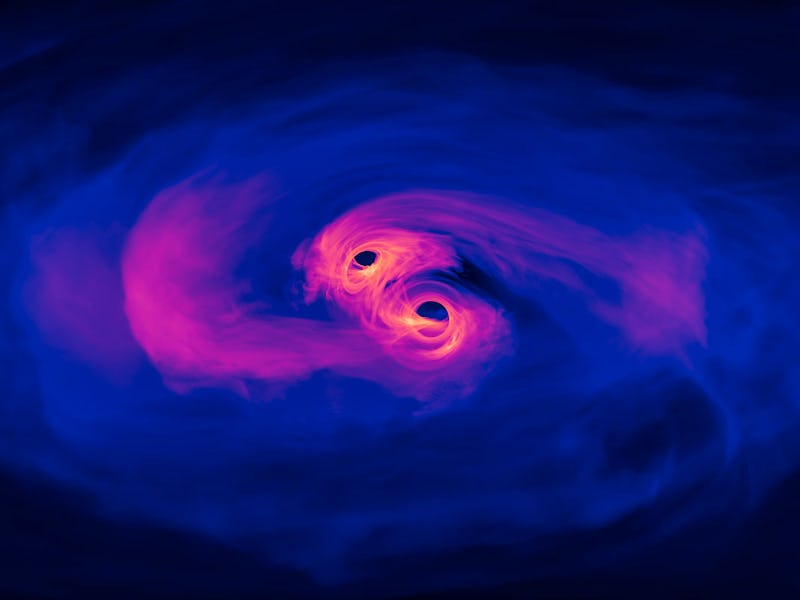Astronomers are gearing up for never-before-seen merger between two black holes
It could take place any time from 100 days to three years.

Astronomers are watching the skies, waiting for two cosmic giants to collide.
In a galaxy located 1.2 billion light years from Earth, a pair of black holes could potentially be engaged in a gravitational tango, pulling closer to one another until they merge as one supermassive black hole. This could occur as soon as 100 days, or up to three years from now.
If this iconic merger does take place, it would be the first time astronomers witness an event of this kind and provide significant clues as to how black holes grow to their supermassive sizes.
The researchers detail their tantalizing prediction in a study available on the preprint server arXiv.
Huan Yang, a researcher at the Perimeter Institute in Waterloo, Canada, and co-author of the study, understands why some astronomers have shown skepticism regarding the upcoming merger.
“I think people have doubt, and that’s totally reasonable,” he tells Inverse. “People are thinking, ‘ah, what if this thing doesn’t sustain?’”
Yang joined his colleague, Ning Jiang from the University of Science and Technology of China, in unraveling this cosmic mystery.
Using data from a survey telescope in California called the Zwicky Transient Facility, Jiang first noticed a unique behavior in the light curve coming from a distant galaxy. The astronomer interpreted the signal to be coming from a binary pair of black holes, but things got even more interesting from there.
The separation between the two black holes was getting more narrow, changing from one light year to one light month within three years of observations.
“Normally, you’d imagine the separation between the binary is still large so that the period shouldn’t change during the observation period,” Yang says. “But this signal is unique. The period just changed so rapidly in time in a way that was never seen before.”
If this ongoing signal pattern continues, then the binary objects would get as close to each other as the distance between the Sun and Pluto.
From there, the team of researchers believe that they stumbled upon something spectacular, an encroaching merger of two giant black holes that could take place in a period as short as 100 days but more likely within the next three years.
Follow-up observations are needed to make a better prediction of the timeline.
Andrew Fabian, a professor at the Institute of Astronomy at the University of Cambridge, is gearing up for this possible merger by booking time on NASA’s space-based X-ray telescope NuStar even though he doesn’t really know what to expect from the actual event.
“It has never been witnessed before,” Fabian tells Inverse. “At the moment there is quite a lot of gas but the violent acceleration of the orbits as they approach each other may cause a massive outflow of gas. This could be quite luminous or could even obscure the situation.”
Astronomers have predicted black hole mergers before, but never witnessed one in real-time. The one thing scientists know about black holes is their massive size, and yet they are not quite sure how they came to grow to their stature.
Black holes feed on surrounding material, which does increase their size. But that alone may not be enough to account for just how massive some of these cosmic beasts are, about 20 billion times the mass of the Sun.
Another way black holes may be growing to their gigantic size is through merging with other black holes. Scientists believe that black holes lurk at the center of every galaxy, and as these galaxies merge, the black holes get caught up in the middle with their gravitational force tugging on one another.
If scientists are able to observe the merging event between two black holes, it will resolve a lot of the mysteries surrounding these cosmic giants.
“You will be able to test all your predictions using this single example,” Yang says.
Abstract — Supermassive black hole binaries (SMBHs) are a fascinating byproduct of galaxy mergers in the hierarchical universe. In the last stage of their orbital evolution, gravitational wave radiation drives the binary inspiral and produces the loudest siren awaiting to be detected by gravitational wave observatories. Periodically varying emission from active galactic nuclei has been proposed as a powerful approach to probe such systems, although none of the identified candidates are close to their final coalescence such that the observed periods stay constant in time. In this work, we report on the first system with rapid decaying periods revealed by its optical and X-ray light curves, which has decreased from about one year to one month in three years. Together with its optical hydrogen line spectroscopy, we propose that the system is an uneven mass-ratio, highly eccentric SMBH binary which will merge within three years, as predicted by the trajectory evolution model. If the interpretation is true, coordinated, multi-band electromagnetic campaign should be planned for this first binary SMBH merger event observed in human history, together with possible neutrino measurements. Gravitational wave memory from this event may also be detectable by Pulsar Timing Array with additional five-to-ten year observation.